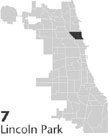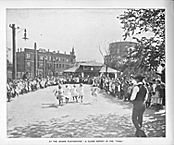| Entries |
| L |
|
Lincoln Park
|
 Community Area 7, 3 miles N of the Loop. During the nineteenth century, the inhabitants of the future Lincoln Park
Community Area
ranged from affluent residents focused on the park and the
Loop,
to
German
farmers and shopkeepers oriented to North Avenue, to industrial workers living near the factories along the North Branch of the
Chicago River.
Most of the early European residents were German truck farmers, whose products earned the area the nickname “Cabbage Patch.” By 1852 the German community was well enough established to begin work on St. Michael's
Roman Catholic
Church, which was named for the patron saint of local
brewer
and land donor Michael Diversey. The city of Chicago made the southeastern portion of the area its
cemetery
in 1837, but the graves proved such a health hazard that the cemetery was moved and the land redesignated Lake Park in 1864. It was renamed
Lincoln Park
the next year for the assassinated president. This recreational center attracted such cultural institutions as the
Chicago Academy of Sciences,
the
Lincoln Park Zoo,
and the
Chicago Historical Society.
In 1863, Cyrus McCormick sponsored the opening of the Presbyterian Theological
Seminary
of the Northwest in northwestern Lincoln Park; the school was later renamed for its benefactor.
Community Area 7, 3 miles N of the Loop. During the nineteenth century, the inhabitants of the future Lincoln Park
Community Area
ranged from affluent residents focused on the park and the
Loop,
to
German
farmers and shopkeepers oriented to North Avenue, to industrial workers living near the factories along the North Branch of the
Chicago River.
Most of the early European residents were German truck farmers, whose products earned the area the nickname “Cabbage Patch.” By 1852 the German community was well enough established to begin work on St. Michael's
Roman Catholic
Church, which was named for the patron saint of local
brewer
and land donor Michael Diversey. The city of Chicago made the southeastern portion of the area its
cemetery
in 1837, but the graves proved such a health hazard that the cemetery was moved and the land redesignated Lake Park in 1864. It was renamed
Lincoln Park
the next year for the assassinated president. This recreational center attracted such cultural institutions as the
Chicago Academy of Sciences,
the
Lincoln Park Zoo,
and the
Chicago Historical Society.
In 1863, Cyrus McCormick sponsored the opening of the Presbyterian Theological
Seminary
of the Northwest in northwestern Lincoln Park; the school was later renamed for its benefactor.

|
During the Great Depression, Lincoln Park's housing stock deteriorated as owners subdivided and neglected their properties. After World War II, residents of Old Town, in the southeastern section of Lincoln Park, worried that their neighborhood hovered on the verge of becoming a slum. They formed the Old Town Triangle Association in 1948, which inspired residents of the mid-North neighborhood to create a similar organization in 1950. In 1954 the Lincoln Park Conservation Association was organized to cover the entire community area. LPCA pursued neighborhood renewal by encouraging private rehabilitation of property and the use of government tools such as federal urban-renewal funds and enforcement of the housing code. In 1956, Lincoln Park was designated a conservation area, and in the 1960s the city began implementing its “General Neighborhood Renewal Plan.” Although the LPCA had consciously tried to avoid the wholesale clearance that took place in Hyde Park, it incurred the wrath of poor people who lived in the southwestern quarter of Lincoln Park. The Concerned Citizens of Lincoln Park argued that Puerto Ricans and African Americans were being displaced from their homes and priced out of the renewing neighborhood. Developers bought land near the park and built high-rise apartment buildings, to the consternation of LPCA, which had hoped to keep the district congenial to families.
In the last quarter of the twentieth century, land values increased dramatically, making it difficult for people and institutions in financial straits to remain in Lincoln Park. Most of the poor left. In 1973, the struggling McCormick Seminary sold its land to DePaul and moved to Hyde Park. Single professionals and childless couples moved into the new high-rises and rehabilitated old houses. By the end of the twentieth century, the combination of public and private urban renewal efforts had made Lincoln Park one of the highest-status neighborhoods in the city.
| Lincoln Park (CA 7) | |||||
| Year |
Total
(and by category) |
Foreign Born | Native with foreign parentage | Males per 100 females | |
| 1930 | 97,873 | 33.8% | 36.8% | 106 | |
| 97,393 | White (99.5%) | ||||
| 143 | Negro (0.1%) | ||||
| 337 | Other (0.3%) | ||||
| 1960 | 88,836 | 17.3% | 21.7% | 97 | |
| 84,604 | White (95.2%) | ||||
| 1,358 | Negro (1.5%) | ||||
| 2,874 | Other races (3.2%) | ||||
| 1990 | 61,092 | 7.6% | — | 92 | |
| 53,900 | White (88.2%) | ||||
| 3,717 | Black (6.1%) | ||||
| 79 | American Indian (0.1%) | ||||
| 1,504 | Asian/Pacific Islander (2.5%) | ||||
| 1,892 | Other race (3.1%) | ||||
| 3,981 | Hispanic Origin* (6.5%) | ||||
| 2000 | 64,320 | 8.1% | — | 96 | |
| 56,140 | White alone (87.3%) | ||||
| 3,394 | Black or African American alone (5.3%) | ||||
| 129 | American Indian and Alaska Native alone (0.2%) | ||||
| 2,337 | Asian alone (3.6%) | ||||
| 27 | Native Hawaiian and Other Pacific Islander alone (0.0%) | ||||
| 1,245 | Some other race alone (1.9%) | ||||
| 1,048 | Two or more races (1.6%) | ||||
| 3,254 | Hispanic or Latino* (5.1%) | ||||
The Encyclopedia of Chicago © 2004 The Newberry Library. All Rights Reserved. Portions are copyrighted by other institutions and individuals. Additional information on copyright and permissions.